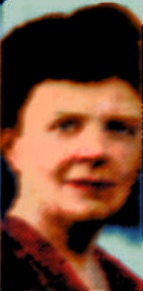The Pittsburgh Press (December 2, 1945)

I DARE SAY —
Crawford, Bacall and a few of our ace comics, including Butterworth
By Florence Fisher Parry
People are still flocking in great droves to find out what Mildred Pierce did. It seems that the picture is a stunning success, and now we can look for a series of Joan Crawford martyred mothers. That is to say, you look for them. I beg to be excused.
Maybe the matter is with me, for “Mildred Pierce” to me was what I would call pure trash. When I compare its story, content, treatment and star with practically all our other top-drawer pictures, I am appalled at the cheap tastes that such a picture as “Mildred Pierce” seems to indulge. The amazing thing is that a picture like this causes just as much excitement in the inner circles of Hollywood as in the movie fans. There’s no way to describe the genuine respect in which “Mildred Pierce” was held in and around Warner Brothers Studio before its release. Everybody spoke in awed, tranced whispers about the beautiful and inspired performance of Joan Crawford. I was given to feel that I had denied myself a masterpiece in omitting to see it in preview.
Now the success of such a picture as “Mildred Pierce” wouldn’t excite in me such astonishment were it not for the fact that there are so many really first-class pictures being made. The quality of Hollywood’s product has so improved since the old Joan Crawford-Norma Shearer days that when a picture as old-fashioned as “Mildred Pierce” appears, it is as though we were being hauled back to the days of “Stella Dallas” and “Dancing Daughters.”
Joan Crawford has made a comeback. all right, with an accent on the “back,” for she has taken her movie audiences back with her a good 10 years.
Mind you, I liked her. I enjoyed her good, old-fashioned frontal attack upon the sob-centers of her movie fans. Nothing subtle here: just good, strong ham. And I found myself thinking how many good hams have been spoiled for us by too much refined direction. Think what a grand ham Bette Davis would be if they’d really let her cut loose! Yes, and Barbara Stanwyck, too, and several others among our stalwart old-timers. In this regard, “Mildred Pierce” was almost refreshing.
![]()
Maybe, I find myself thinking, the true test of screen talent can be found in this:
How successfully could it be transferred to the stage? Think of your screen favorites and picture them in the theater, and you will be able very quickly to distinguish between the true actor and the spurious. With what ease we can picture Ingrid Bergman or Irene Dunne on the legitimate stage! Yet how suddenly out of place would seem Joan Crawford or Bette Davis!
Real actors can make the transfer with far greater ease and success. Spencer Tracy is just as much at home in Sherwood’s play “The Rugged Path” as in the picture “A Guy Named Joe,” albeit his stage vehicle creaks with the weight of maladroit messages. Ralph Bellamy returned to the theater without so much as a stumble. Recently in “State of the Union” we saw a cast made up almost entirely of motion picture people; its young feminine lead, Ruth Hussey, a revelation to her movie fans.
![]()
In New York today nearly every dramatic and musical show is studded with motion picture actors. John Van Druten’s new play “The Mermaids Singing” has in it Walter Abel and Lois Wilson, Frank Fay, Mady Christins, Oscar Holmolka, Martha Scott, Dame May Whitty, Brian Ahern, Arlene Francis, Michael O’Shea, Edmund Gwenn – movie name after movie name blazes on New York’s theater marquee.
And now our important musical shows and comedies are emblazoning their names. What in radio, what in the movies, could ever supply Milton Berle with the chance that is his to perform his comic magic in the theater? Recently this amazing comedian appeared at the Nixon in one of the trashiest musical shows ever devised. and carried it singlehanded and kept the audience his from rise to fall of curtain. And this week, in a comedy which is bruited to be one of the most engaging Pittsburgh will ever split its sides over. “Brighten the Corner” has as its star Charles Butterworth, whom the movies have claimed all too long.
Classic clowns
Here is one of the two great comic geniuses of understatement whom we have in the theater today. The other, of course, is Victor Moore. These two comedians have perfected the technique of timidity and have become classic clowns in the theater.
And just last week another great comic, who certainly can take his place beside these two passed into theater legend – Robert Benchley.
Robert Benchley became in his short career in the movies the very personification of the American frustrated husband and father. The mixed confusion, resignation and bravado which he managed to convey in his inimitable pantomime, take their place alongside the art of the great clowns of stage, circus and screen history.